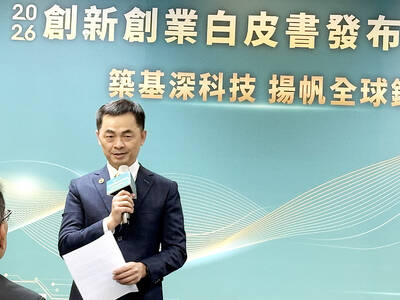The government would trim its GDP growth forecast of 3.76 percent for this year if exports disappoint, but the reading would stay above the 3 percent mark, National Development Council Minister Kung Ming-hsin (龔明鑫) told lawmakers yesterday.
Kung made the remarks as lawmakers raised concerns over the economy, inflation and monetary policy.
The Directorate-General of Budget, Accounting and Statistics, which in August cut its growth forecast for this year to 3.76 percent, could revise it down again next month if exports fare weaker than expected, Kung said.

Photo: Screen grab from the Legislative Yuan television channel
Exports, the mainstay of Taiwan’s small and open economy, likely had slipped into contraction mode last month after squeezing a mild 2 percent gain in August, the Ministry of Finance has said.
Shipments of tech products slowed drastically in August, while those of non-tech products dipped into negative territory. The government is to release last month’s trade data tomorrow.
Kung voiced confidence that GDP growth would exceed 3 percent this year, but expressed reservations when asked if it would be larger than 3.5 percent.
Growth in the consumer price index for last month is forecast to remain above 2 percent, but is likely to be weaker than August’s growth of 2.66 percent due to a drop in international oil prices, he said.
However, it would be difficult for world energy prices to slump given lingering supply issues, Kung said, adding that while oil prices have sagged, natural gas prices remain high amid the war in Ukraine.
Central banks in advanced nations would reconsider the wisdom of drastic tightening to curb inflation after the UN on Monday warned that the monetary policies of wealthy nations could spark a global economic downturn, Kung said.
Lawmakers from across party lines expressed unease that capital flight would persist, and hurt the local currency and share prices given Taiwan’s widening interest rate gap with major economies.
The global economy would slow from a forecast 2.5 percent growth this year to 2.2 percent next year, a slowdown that would leave global GDP well below its pre-COVID-19 pandemic norm and cost the world economy about US$17 trillion, or 20 percent of the world income, if major central banks press ahead with steep rate hikes, the UN said.
Foreign funds would shift their focus back to economic fundamentals and value local shares again after making moves to reflect global monetary tightening, Kung said.
The minister voiced reservations about suggestions to distribute tax surpluses to stimulate private consumption, saying that the public would most likely save instead of spend the money.

CHIP RACE: Three years of overbroad export controls drove foreign competitors to pursue their own AI chips, and ‘cost US taxpayers billions of dollars,’ Nvidia said China has figured out the US strategy for allowing it to buy Nvidia Corp’s H200s and is rejecting the artificial intelligence (AI) chip in favor of domestically developed semiconductors, White House AI adviser David Sacks said, citing news reports. US President Donald Trump on Monday said that he would allow shipments of Nvidia’s H200 chips to China, part of an administration effort backed by Sacks to challenge Chinese tech champions such as Huawei Technologies Co (華為) by bringing US competition to their home market. On Friday, Sacks signaled that he was uncertain about whether that approach would work. “They’re rejecting our chips,” Sacks

NATIONAL SECURITY: Intel’s testing of ACM tools despite US government control ‘highlights egregious gaps in US technology protection policies,’ a former official said Chipmaker Intel Corp has tested chipmaking tools this year from a toolmaker with deep roots in China and two overseas units that were targeted by US sanctions, according to two sources with direct knowledge of the matter. Intel, which fended off calls for its CEO’s resignation from US President Donald Trump in August over his alleged ties to China, got the tools from ACM Research Inc, a Fremont, California-based producer of chipmaking equipment. Two of ACM’s units, based in Shanghai and South Korea, were among a number of firms barred last year from receiving US technology over claims they have

BARRIERS: Gudeng’s chairman said it was unlikely that the US could replicate Taiwan’s science parks in Arizona, given its strict immigration policies and cultural differences Gudeng Precision Industrial Co (家登), which supplies wafer pods to the world’s major semiconductor firms, yesterday said it is in no rush to set up production in the US due to high costs. The company supplies its customers through a warehouse in Arizona jointly operated by TSS Holdings Ltd (德鑫控股), a joint holding of Gudeng and 17 Taiwanese firms in the semiconductor supply chain, including specialty plastic compounds producer Nytex Composites Co (耐特) and automated material handling system supplier Symtek Automation Asia Co (迅得). While the company has long been exploring the feasibility of setting up production in the US to address

OPTION: Uber said it could provide higher pay for batch trips, if incentives for batching is not removed entirely, as the latter would force it to pass on the costs to consumers Uber Technologies Inc yesterday warned that proposed restrictions on batching orders and minimum wages could prompt a NT$20 delivery fee increase in Taiwan, as lower efficiency would drive up costs. Uber CEO Dara Khosrowshahi made the remarks yesterday during his visit to Taiwan. He is on a multileg trip to the region, which includes stops in South Korea and Japan. His visit coincided the release last month of the Ministry of Labor’s draft bill on the delivery sector, which aims to safeguard delivery workers’ rights and improve their welfare. The ministry set the minimum pay for local food delivery drivers at